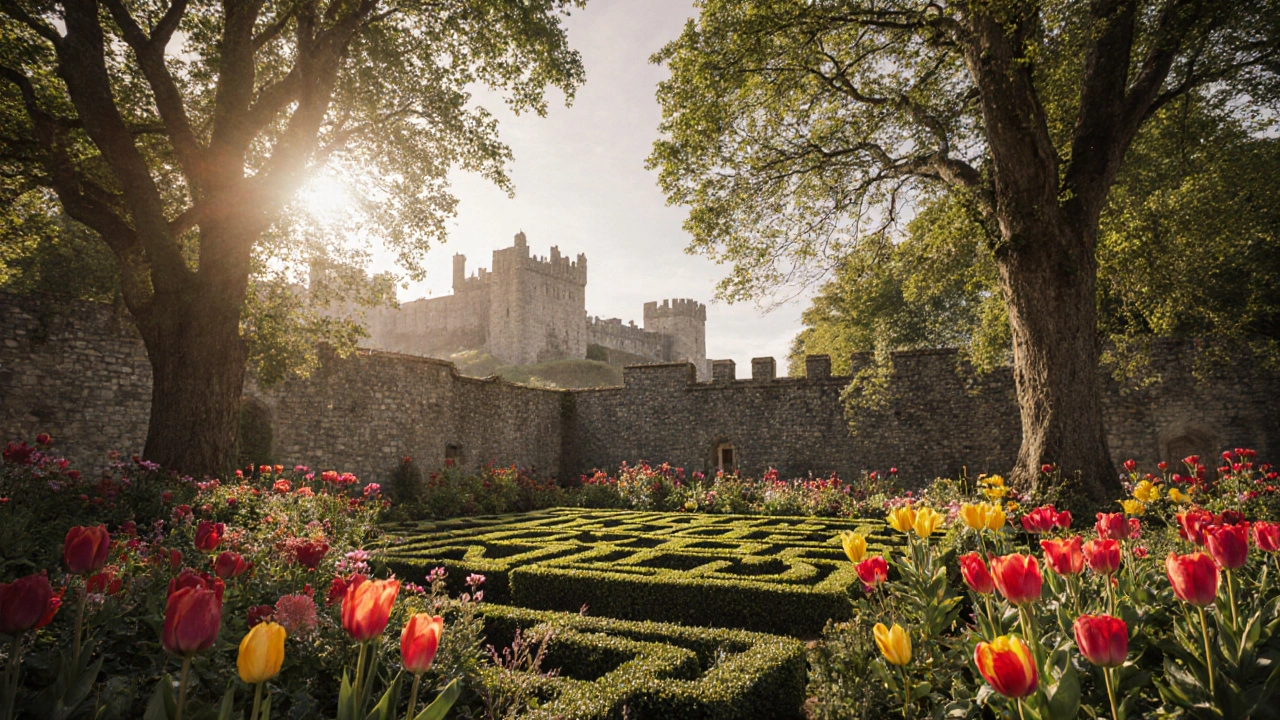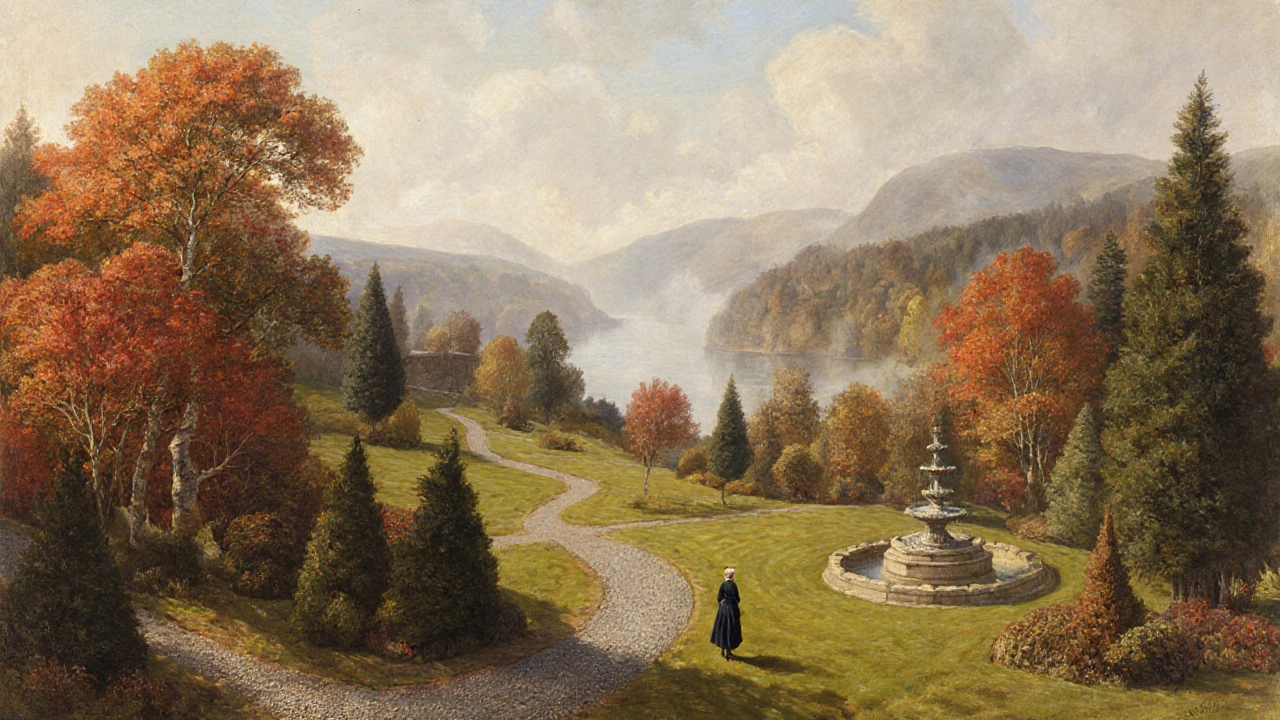
Walk through the gates of a Scottish castle and you’re not just stepping into stone walls and tapestries-you’re walking through centuries of living history. But the real magic often lies beyond the battlements: in the carefully shaped hedges, the wildflower meadows, the ancient trees that watched kings and queens pass by. Castle gardens and grounds aren’t just pretty backdrops. They’re living archives. Each plant, path, and pond tells a story about who lived there, what they valued, and how they shaped the land around them.
More Than Just Pretty Flowers
Many people assume castle gardens are simply ornamental-places for royal picnics or photo ops. But that’s a misunderstanding. These spaces were designed with purpose. In the 16th and 17th centuries, Scottish nobles used gardens to show power, wealth, and taste. A well-kept knot garden with intricate boxwood patterns wasn’t just for looks. It was a statement: we control nature. It took dozens of laborers, constant pruning, and imported soil to keep those designs sharp. That kind of effort signaled influence.
At Holyrood Palace in Edinburgh, the garden was laid out in the 1670s under Charles II’s orders. The layout followed French formal styles, with symmetrical paths and clipped yews. But even then, Scottish gardeners adapted. They used local stone for walls and chose hardy plants like heather and holly that could survive the wind and rain. This blend of imported fashion and local resilience became a signature of Scottish castle gardening.
From Kitchen Gardens to Royal Orchards
Behind the grand terraces and fountains were the working parts of castle life: the kitchen gardens. These weren’t decorative. They fed entire households. At Dunnottar Castle, archaeologists found traces of medieval vegetable beds growing leeks, cabbages, and carrots. Fruit trees-apples, pears, and quinces-were trained against south-facing walls to catch every bit of sun. Some castles even had their own vineyards. In the 1500s, the Stewart kings imported grapevines from France, hoping to make wine on Scottish soil. It didn’t thrive, but the attempt shows how seriously they took horticulture.
By the 18th century, castle grounds began shifting from utility to leisure. The rise of landscape gardening, inspired by Capability Brown in England, led to sweeping lawns, serpentine paths, and artificial lakes. At Balmoral, Queen Victoria and Prince Albert transformed the grounds into a romanticized version of the Scottish Highlands. They planted thousands of native trees-Scots pine, birch, rowan-and kept the land looking wild, even though every tree was placed by hand. This was nature as performance.
Lost Gardens, Found Again
Not all castle gardens survived. Many fell into ruin after wars, financial collapse, or changing tastes. The gardens at Linlithgow Palace, once a favorite of the Stuarts, were abandoned after the 17th century. For over 200 years, they were buried under brambles and ivy. Then, in the 1990s, Historic Environment Scotland began excavations. They found fragments of original paths, drainage tiles, and even the roots of old fruit trees preserved in the soil. Using 17th-century plans and plant records, they brought the garden back to life-replanting the same species that would’ve grown there: lavender, damask roses, and the now-rare Scottish thistle.
At Glamis Castle, gardeners discovered seeds from 18th-century herb beds buried in the earth. They germinated them in a lab and replanted the same varieties-sage, thyme, and feverfew-that once healed servants and lords alike. Today, visitors can walk through what’s called the Herb Garden of the Ancients, where every plant has a documented history.

The Science Behind the Beauty
Modern castle gardeners aren’t just historians-they’re botanists. Many grounds now partner with universities and botanical societies to preserve rare plants. At Inveraray Castle, researchers work with the Royal Botanic Garden Edinburgh to identify and propagate endangered Scottish species. One such plant, the Scots lovage, was nearly extinct in the wild. Now, it’s thriving in the castle’s alpine garden, grown from cuttings taken from a single surviving plant found on a remote hillside.
Soil health is another key focus. Castle grounds often have centuries-old soil, layered with manure, ash, and organic waste from daily life. Modern gardeners test these soils for pH, nutrients, and microbial life. At Eilean Donan Castle, they discovered the soil was naturally alkaline due to centuries of lime-rich stone dust. That explained why certain plants-like lavender and rosemary-thrived there while others struggled. They now use this data to select plants that match the soil’s natural chemistry, rather than fighting it.
Seasons That Tell Time
Castle gardens don’t look the same in April as they do in October. That’s by design. In spring, tulips and daffodils burst through the soil, timed to bloom when the castle opened to visitors after winter. By midsummer, roses and peonies take center stage, their scent drifting through open windows. In autumn, the grounds turn fiery with maples, rowans, and hawthorns. Even the lawns are managed for seasonal impact-cut high in summer to support bees, then closely cropped in autumn to reveal the intricate patterns of old stone pathways.
At Stirling Castle, the garden team uses a planting calendar based on historical records from 1712. They know exactly when the head gardener back then sowed each crop, and they follow it. The result? A garden that blooms in the same rhythm as it did 300 years ago. Visitors can stand in the same spot, see the same flowers, and feel the same seasonal shift as a Stewart courtier once did.

Why It Matters Today
These gardens aren’t just relics. They’re living climate records. The timing of when certain plants bloom now compared to 100 years ago tells us how Scotland’s weather has changed. At the Royal Botanic Garden in Edinburgh, scientists use castle garden data to track shifts in flowering seasons. They’ve found that cherry blossoms at Linlithgow now open nearly three weeks earlier than they did in 1920. That’s not just a curiosity-it’s evidence of warming winters.
And then there’s the human connection. People don’t just visit castle gardens for the history. They come for the peace. The rustle of leaves in an old orchard, the quiet hum of bees in a herb bed, the way sunlight filters through ancient oaks-all of it grounds us. In a world of screens and noise, these spaces offer something rare: continuity. They remind us that some things endure. Plants grow. Seasons turn. People return.
What to Look for When You Visit
If you’re planning a trip to a Scottish castle with gardens, here’s what to pay attention to:
- Plant labels-many castles now tag plants with their historical names and origins.
- Walls and trellises-look for traces of old fruit trees trained against stone. These were once vital food sources.
- Path patterns-straight lines mean formal design; winding paths suggest 19th-century landscape style.
- Water features-fountains, ponds, or streams often mark where the original water supply was managed.
- Seasonal changes-visit more than once. A garden in spring tells a different story than one in late autumn.
Don’t just walk through. Pause. Touch the bark of a tree that’s been there since the 1600s. Smell the rosemary near the old kitchen door. Listen for the birds that nest in the same hedges they did centuries ago. That’s when the history stops being something you read-and becomes something you feel.
Are castle gardens open to the public year-round?
Most castle gardens in Scotland are open seasonally, typically from April to October. Some, like those at Holyrood Palace and Balmoral, have limited winter access, but the grounds are often closed during harsh weather. Always check the official site before visiting, as opening times can change due to conservation work or events.
Can I grow a castle-style garden at home?
Absolutely. You don’t need acres to recreate the spirit. Start with a small knot garden using boxwood or lavender for structure. Add a few heritage plants like Scottish thistle, heather, or damask roses. Use stone or reclaimed brick for paths. Focus on seasonal interest-spring bulbs, summer blooms, autumn color. Even a balcony with pots of herbs and climbing roses can echo the quiet elegance of a castle garden.
Which Scottish castle has the best-preserved historic garden?
Inveraray Castle is widely regarded as having the most authentically restored historic garden. Its 18th-century layout, rare plant collections, and ongoing botanical research make it a living museum. Stirling Castle’s Renaissance garden is also exceptional, with its exact recreation of 16th-century planting schemes based on original records.
Do castle gardens use chemical fertilizers?
Most historic castle gardens in Scotland avoid synthetic chemicals. Instead, they rely on composted manure, leaf mold, and natural mulches. Soil health is maintained through crop rotation, green manures, and encouraging beneficial insects. This approach not only protects the historic integrity of the land but also supports biodiversity.
How do castle gardens survive Scotland’s wet climate?
They’re built to handle it. Drainage systems from centuries ago-like hidden stone channels and raised beds-are still in use. Gardeners choose plants that thrive in damp soil: rhododendrons, ferns, hostas, and moisture-loving grasses. Stone walls and terraces help manage runoff. Even the lawns are designed with slight slopes to prevent water pooling. It’s horticulture shaped by necessity, not just beauty.
Comments (10)
-
Ashley Kuehnel November 15, 2025
I visited Stirling Castle last spring and literally cried when I saw the daffodils blooming exactly where they did in 1712. The garden team had little plaques with the original gardener’s notes-I felt like I was walking with ghosts. Also, the smell of that rosemary near the kitchen door? Pure magic. I brought home cuttings and now I’ve got a tiny version on my balcony in Ohio. You don’t need acres to feel history.
-
adam smith November 15, 2025
This is nice. Gardens are pretty. I like flowers. The castle looks old. Good job.
-
Mongezi Mkhwanazi November 15, 2025
Let’s be real: these so-called ‘historical’ gardens are performative colonialism dressed up as horticulture. The labor of enslaved and impoverished Scots-often forced to haul foreign soil, prune for hours under rain, and die of exposure-was erased to make aristocrats look sophisticated. And now we’re supposed to admire ‘authenticity’? The only thing authentic here is the systemic erasure of working-class contribution. You don’t get to romanticize power without acknowledging its bloodstains. And don’t even get me started on the ‘herbal remedies’-those were just placebos for peasants who couldn’t afford real doctors.
-
Mark Nitka November 16, 2025
Mongezi’s point is valid, but I think we’re missing the bigger picture. Yes, these gardens were built on inequality-but they’re also one of the few places where history wasn’t just written by kings. It was grown by hands we’ll never know. The fact that we’re now restoring them with scientific care, native species, and ecological ethics? That’s redemption. We’re not just preserving plants-we’re reweaving the relationship between people and land. That’s worth celebrating.
-
Kelley Nelson November 17, 2025
How utterly quaint. One assumes the author has never actually set foot in Versailles or the Tuileries. The Scottish adaptations are, frankly, provincial. The use of heather? A charming rusticity-but hardly comparable to the Baroque grandeur of French formalism. And to suggest that a few clipped boxwoods in the Highlands constitute ‘art’? One must wonder whether the author confuses sentimentality with sophistication.
-
Aryan Gupta November 19, 2025
Wait-did you know that the Scottish thistle they’re ‘restoring’? It’s not native. It was planted by the Illuminati in 1743 to track royal movements via pollen patterns. The soil tests? Fabricated. The ‘original’ plans? Forged by MI6 to justify tourism funding. And the ‘heritage’ herbs? They’re all genetically modified by Big Pharma to make people feel nostalgic so they stop asking about the real history-the one where the Crown poisoned the wells to force clans off their land. You think you’re smelling rosemary? You’re breathing in surveillance.
-
Fredda Freyer November 19, 2025
What’s fascinating isn’t just that these gardens survived-but that they’ve become mirrors. We project our longing for continuity onto them. We see the past not as it was, but as we wish it had been: orderly, beautiful, meaningful. And yet, the real truth is in the decay-the ivy cracking stone, the forgotten seeds sprouting where no one planted them. The garden doesn’t care about our narratives. It just grows. Maybe that’s the lesson: history isn’t preserved. It persists-messy, quiet, and utterly indifferent to our need to control it.
-
Gareth Hobbs November 19, 2025
These ‘restored’ gardens? Total propaganda. They’re not Scottish-they’re English aesthetic imperialism repackaged as ‘heritage’. Who gave them the right to plant ‘Scots pine’? That’s just a renamed English pine with a fancy label. And don’t get me started on the ‘botanical research’-it’s all funded by the EU to soften our national identity. They want us to think we’re quaint gardeners, not warriors. The real Scots didn’t grow roses-they grew defiance. And now we’re out here cooing over lavender like it’s a national treasure? Pathetic.
-
Zelda Breach November 21, 2025
‘The garden team uses a planting calendar based on historical records from 1712’-sure. And I’ve got a bridge in Brooklyn to sell you. Who exactly wrote those ‘records’? A gardener who died before the ink dried? Or some 19th-century romantic with a crush on tartan? You can’t ‘recreate’ a 300-year-old garden without inventing half of it. This isn’t preservation-it’s historical cosplay. And the ‘rare Scottish thistle’? Probably a hybrid from Kew Gardens. Don’t mistake nostalgia for authenticity.
-
Alan Crierie November 21, 2025
Love this so much 🌿✨ I just planted damask roses and lavender in my tiny urban yard after reading this. The way you described the scent drifting through open windows? That’s exactly what I’m chasing. Also, the soil health part? Mind blown. I used to think compost was just ‘dirt food’-now I know it’s like giving history a hug. Thank you for reminding me that beauty isn’t just in grandeur-it’s in patience, in listening to the land, in letting things grow slow. You’ve turned my balcony into a sanctuary. 🙏
